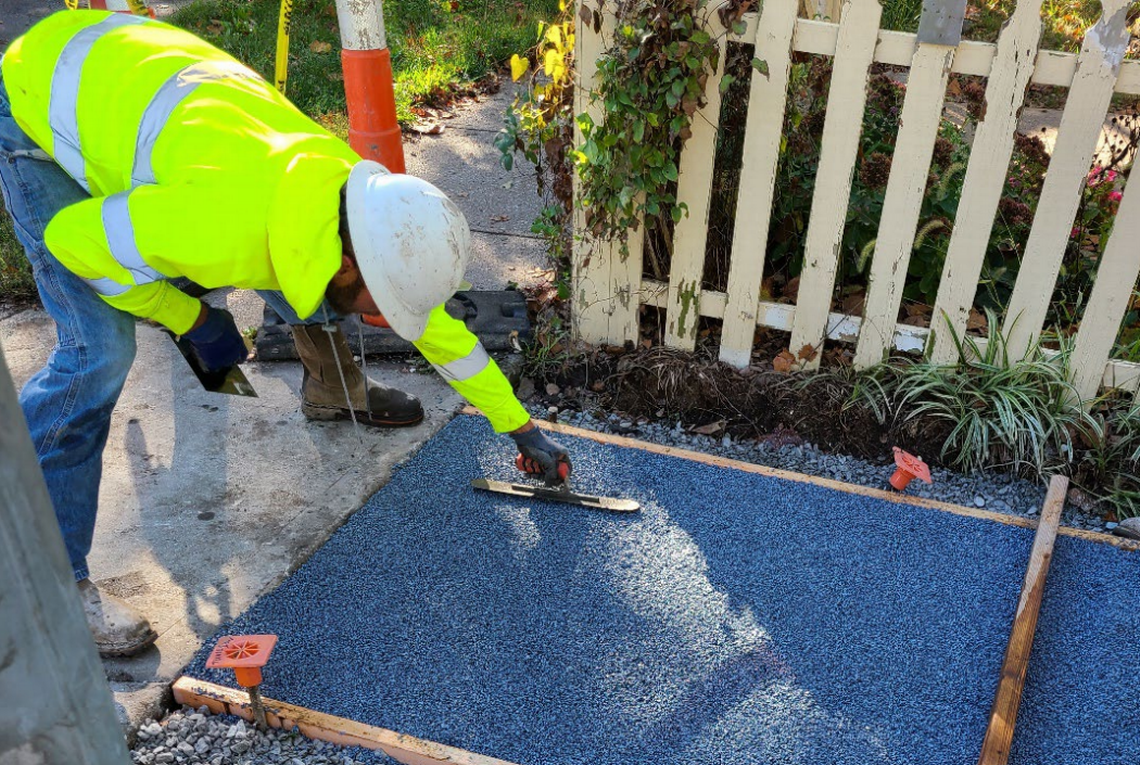New rubber sidewalks are going in around Kansas City. Here’s why, and where to find them

Kansas Citians in certain neighborhoods may find an extra spring in their step this fall.
The city’s Public Works Department is installing new sidewalks made from recycled rubber in select areas around the city.
“Rubber sidewalks… allow responsible tree growth and safe walking, and more,” Mayor Quinton Lucas wrote on social media last week alongside a photo of a newly installed rubber sidewalk in the Waldo neighborhood.
Rubber sidewalks’ increased flexibility makes them less likely to crack or break due to underground movement like shifting soil or growing roots, according to manufacturer Rubberway. City spokesperson Sherae Honeycutt told The Star that the new initiative is focused on areas where trees have caused damage to traditional sidewalks.
“Based on data inspected so far, this application may potentially be used for around 4,000 trees throughout the city,” she said. “We anticipate overall less maintenance, but this is very new, and we will realign and adjust as needed in the future.”
The project doesn’t yet have a specific timeline, but some installations — like the one in Waldo — are already underway.
The rubber sidewalks initiative comes on the heels of a study released earlier this year by the University of Missouri-Kansas City and sponsored by the city’s public works department. It analyzed the costs and benefits of several alternative sidewalk materials, including recycled rubber.
Where will rubberized sidewalks be installed around the city?
The city doesn’t yet have a specific plan for how many miles of rubberized sidewalks it intends to install. Currently, the project is based on tree locations rather than specific neighborhoods.
Trees and sidewalks are both desirable parts of neighborhoods, but they can often exist in conflict. Honeycutt told The Star that the city plans to use data from its 2019-2020 sidewalk inspections to determine where rubberized sidewalks might offer the best solution for trees and residents.
In some areas only a small section may be rubberized to accommodate a tree, while other streets may see a whole block of rubberized sidewalk installed, she said.
“The condition of the trees and mitigation options are carefully considered before any sidewalk repairs,” the city’s Public Works website states.
“If a tree is removed for sidewalk repair or replacement at a particular location, the City Forester’s Office will replace that tree with two new trees in that neighborhood.”
What did the city learn from its rubber sidewalk pilot test?
For the UMKC study, city crews installed a rubber sidewalk along a block of 41st Street in the Hyde Park neighborhood in 2021. The location was chosen in part due to several large tree roots that had cracked the existing concrete sidewalk in the area.
After 18 months of observation, researchers reported positive results.
“The section placed according to the manufacturer’s recommendations had good performance at the time of publication,” they wrote.
However, some residents noticed structural problems with the rubber material.
“I recall when they rolled out the test patch, and it was pretty great until that first winter. (Then) the rubber pellets were torn from the sidewalk, and there were gouges in its entirety,” said longtime Midtown resident Christopher Ciesel, who lived just blocks from the test site during the study period.
“Hopefully the city can execute the new sidewalks in a more durable (and handicap-friendly) manner,” he added. Their flexibility is supposed to make rubberized sidewalks easier to walk on and more accessible to wheelchairs and strollers.
Rubber sidewalks are made of shredded recycled tires, giving the material a semi-porous surface. This ideally allows water to drain through these sidewalks rather than pooling or freezing on top of them.
However, the study noted that the Hyde Park test site was on too steep a slope to measure the material’s water drainage capabilities.
“An additional flat test testing (site) should be installed to verify the product meets design requirements,” the study added.
It’s unclear whether this follow-up test was ever completed. The city did not respond to The Star’s follow-up question about this testing Wednesday.
What are the environmental impacts of rubberized sidewalks?
Rubberway, which makes the sidewalk material the city is now using, touts the product’s contributions to sustainability.
Since its rubber is largely sourced from recycled tires, UMKC researchers noted that the one-block test section of rubber sidewalk used in the study sequestered 322 pounds of CO2. That’s roughly the amount produced by burning one tank of gasoline in a large car.
However, the long-term environmental impacts of rubber sidewalks aren’t yet well studied.
Tire rubber has been tied to a number of environmental harms, including a chemical called 6PPD that has decimated fish populations in rivers around the U.S. A 2020 California study also found that rubberized pavement leaches 40% more zinc oxide than non-rubberized pavement.
Rainwater flowing through sidewalks made of tire rubber may also contribute to microplastics in stormwater — and a U.K. study published this summer found that tire rubber particles can cause up to four times the environmental harm of other microplastics.
A Rubberway representative said Wednesday that the company provided Kansas City with significant documentation of the material’s environmental safety and durability under extreme conditions like high heat.
But in a response to questions Thursday, the company declined to share specific details about these qualities with The Star.
Do you have more questions about public works in Kansas City? Ask the Service Journalism team at kcq@kcstar.com.

